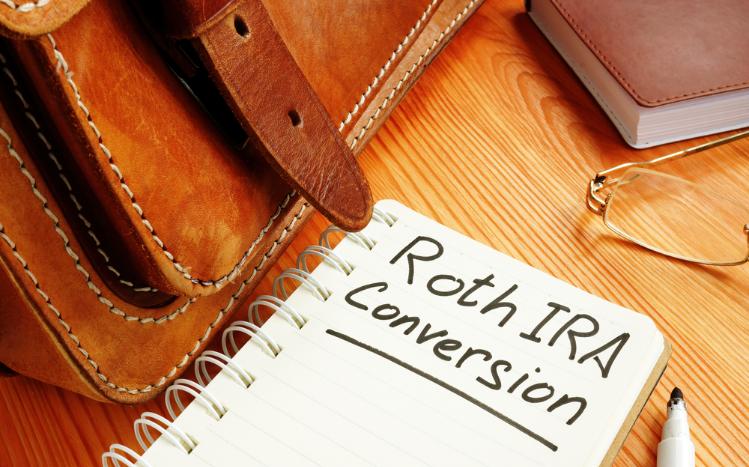Roth IRA conversions are probably one of the last remaining strategies that retirement account holders can utilize to shelter future income and gains from tax. The question of whether one should engage in a Roth IRA conversion is quite common, but unfortunately, there is not always one right answer. This is because there are several important factors to consider before electing to convert a pretax IRA to a Roth. The good news is that since 2010, anyone can elect to do a Roth conversion, even someone who is retired. Let me explain.
- A Roth conversion is process of moving pretax IRA funds to an after-tax account
- Anyone can perform a Roth conversion, even if retired
- Many factors go into deciding the best time to convert
What is a Roth IRA?
The Roth IRA was created by the late Senator Roth of Delaware in 1997. It is an after-tax IRA, which, unlike a traditional IRA, does not offer an immediate tax deduction to the IRA holder for making Roth contributions. However, if the Roth has been open at least five years and you are over the age of 59 ½, then all Roth distributions are tax-free. In addition, there are no required minimum distributions for Roth IRAs so you can let it grow unhindered.
Roth IRA Eligibility
The maximum Roth IRA contribution for 2022 is $6,000, or $7,000 if you are at least age 50. Contributions can be made until April 15 of next year. The Roth IRA rules impose income limitations on who can make Roth contributions. If one has an annual income above $144,000 (single) or $214,000 (married) then direct contributions are not allowed. However, there is a workaround known as the “Backdoor” Roth IRA, which we will talk about later.
What is a Roth Conversion?
A Roth conversion offers a retirement account holder the ability to convert pretax funds to a Roth (after-tax account). The advantage of a conversion is that all income and gains from the Roth investments can be taken as a tax-free distribution. The downside of a conversion is that tax is due on the amount of cash or fair market value of the asset being converted. Note that the tax on a Roth IRA conversion is ordinary income and not capital gains. When performing a conversion, there is no age restriction, so there is no early distribution penalty.
Funds converted to Roth are subject to ordinary income tax. Those who are under age 59 ½ at the time of conversion must wait until they reach that age and any Roth has been open for at least five years. If you are over that age, the amount converted can be withdrawn at any time without tax. However, to get tax-free use of any earnings, they would need to remain in the IRA for the five-year waiting period.
Roth IRA Conversion Advantages/Disadvantages
Before electing to do a Roth IRA conversion, there are a number of important factors to consider:
- Your ability to pay the tax now with personal funds.
- The availability of losses that could be used to offset any potential tax.
- Your current tax bracket versus your expected tax rate when you have to take required distributions.
- Confidence in the future investments of the Roth IRA, i.e. memories of Bear Stearns.
Tips for Roth Conversion at Retirement
There are a number of unique aspects involved in electing to do a Roth IRA conversion at the age of retirement. The good news is that one can do a conversion at any age, and at any time. The IRS is always happy to collect tax revenue prematurely. However, when one is nearing the age of retirement, he or she is likely in a lower income tax bracket. This makes the conversion less impactful since pretax IRA distributions would carry a smaller tax burden.
However, if an IRA owner at the age of retirement maintained a high-income tax bracket and trusted that would continue for some years, then a Roth IRA conversion could make more sense, assuming the IRA owner has confidence in the underlying IRA investments and would be patient to wait the five years before pulling out the earnings.
The Backdoor Roth IRA
We mentioned earlier that not everyone can contribute to a Roth IRA. If one earns too much to directly contribute to a Roth, the Backdoor Roth will allow them to still get money into the tax-advantaged plan. This is a result of a 2010 law that ended the income limitations for Roth conversions which was put in place to generate additional tax revenues for the Treasury.
One can now make an after-tax IRA contribution (not deductible) and then immediately convert the funds to Roth. Because there are no earnings, this conversion would be tax-free. However, you must keep in mind the pro rata rules if you have other pretax IRA funds. Since you cannot choose which funds are converted, a percentage of your conversion (which would include pretax IRA funds) would be taxable.
Conclusion
Since 2010, anyone with an IRA can do a Roth IRA conversion. The amount converted is subject to ordinary income tax and, depending on the age of the IRA owner, there could be restrictions in terms of taking tax-free distributions. The most important factors to consider before electing to do a conversion is your ability to pay the tax on the amount converted and your belief in the potential future value of your investment(s).
If you strongly believe that they are undervalued compared to their future potential value, it might make sense to convert, pay the taxes now, and reap the rewards later. Of course, you need to be patient and wait for the allotted time before you can take advantage of the tax-free nature of the Roth IRA.







